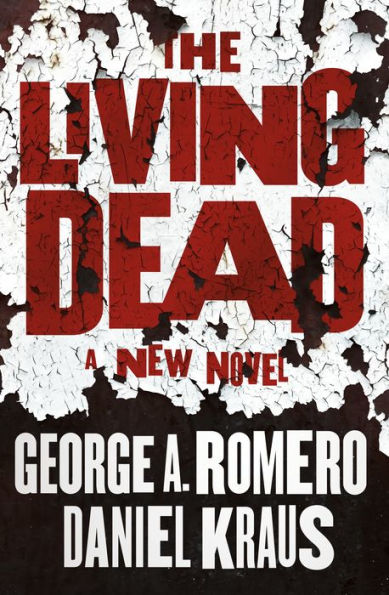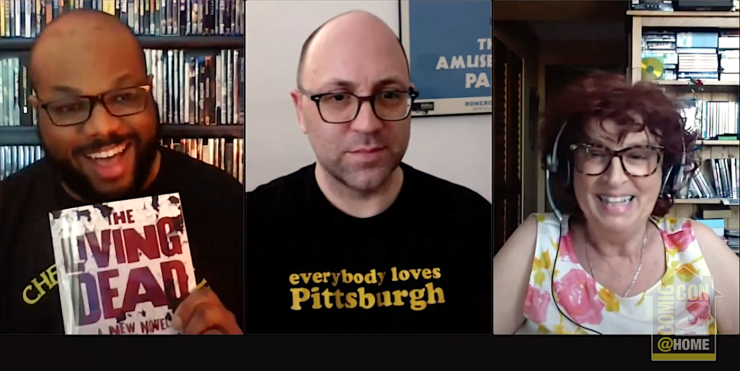George A. Romero was one of our greatest writers and filmmakers and he shaped modern cinema as we know it. One of his best-known innovations was the creation of a new kind of zombie aesthetic. With Night of the Living Dead, Romero took the idea of the zombie (so often used by white filmmakers to cast Black characters and culture as monstrous) and reshaped them into a rich story about class bias and the evils of white supremacy—that also happened to be a perfect, bone-rattlingly scary movie.
While Romero worked in many genre, he returned to zombie stories again and again. One of his projects, an epic novel about the zombie apocalypse that was unfinished at the time of his death, but now completed and shaped by author Daniel Kraus. The Living Dead, will be available from Tor Books on August 4th. As part of San Diego Comic-Con At Home, film scholar and journalist Richard Newby spoke with Kraus and Romero’s partner, Suzanne Desrocher-Romero, about the novel and Romero’s legacy.
You can watch the full panel, or head below for highlights from the conversation.
First, by way of introduction, Daniel Kraus is the author of Rotters, The Death and Life of Zebulon Finch, and, with Guillermo del Toro, Trollhunters and The Shape of Water. He was selected by the Romero Estate to complete The Living Dead, George A. Romero’s final work of zombie fiction. Suzanne Desrocher-Romero is the founder and President of The George A. Romero Foundation, a non-profit organization that supports indie filmmakers, and which recently partnered with The University of Pittsburgh to form the George A. Romero Horror Studies Center. Richard Newby has written for The Hollywood Reporter and The New York Times, among others, and authored this amazing exploration of Night of the Living Dead.
RN: How did you get in the headspace of George Romero?
DK: It’s weird, it felt more like a standard collaboration than you would expect. Segments of the manuscript came at different stages. There was the original chunk that George had written, and then when I was a couple hundred pages into the work we turned up another hundred pages that George had written earlier—sort of a “dry run” for the book….we also found a missing short story that was told from the point of view of a zombie which was really valuable to get a sense of the zombie rules…[I] studied what George loved so I could be inspired by what he was inspired by. His favorite film was (Powell & Pressburger’s) Tales of Hoffman, and I was able to use that film as a scaffolding to build—that opera, Tales of Hoffman, is a three-act structure—I was able to use that as a model for the book’s three-act structure, and as a thematic guide for each act. So I treated it like I was working on an unfinished Rembrandt.
RN: Romero has quite a large fanbase—and I’m included in that! What do you think fans will be really excited about in this new novel, other than the fact that it’s a new novel co-written by George Romero?
DK: There will be sharp and poignant commentary on American society, that I don’t think has ever been more cutting than it is right now. A lot about the haves vs. the have-nots. The book involves a pandemic situation that we can get out of, but only if we work together. Some of the more granular surprises in the book…for instance learning how important zombie animals are! I did a lot of research into George ideas and deleted scenes, and it showed me how interested he was in exploring the idea of zombie animals.
SD-R: I sat down and read it, and it was an emotional experience for me. I had read sections of it before, and the main character or one of the main characters, Luis—I used to call George “Luis” when he was being difficult or negative, because George, he was a “half-empty” kinda guy. But deep down he was all about “full.” He often looked at life with a pessimistic view, and this book reflects that. I have to say, it was emotional I cried, I was touched by the characters, I felt that Dan was the best person to write this book.
Buy the Book


The Living Dead
RN: There’s a comforting presence to George’s voice, and in spite of his pessimism a humanity, I think really carries through in this novel. In terms of his filmography—I just did a re-watch of all of his films, and while he’s best known for his zombie films, Martin, and Knightriders in particular I find a really touching film that was outside the horror box for him. Did any of that impact the writing of this book at all?
DK: I think one of the reasons I appealed to George’s manager Chris Roe as a co-author was that he knew me as a student of George’s, and not just a student of his zombie films, I mean a student, period. I grew up on his movies, and I loved all of them. I don’t think he ever made a bad movie. To get an idea of who he was as a creator and a thinker I had to look at everything he did, the breadth of it. There are Easter egg-type nods to all of his work in the novel, not just his zombie work. Some of them are really subtle, and only a superfan will know! I can’t emphasize enough how important it is to look beyond the obvious six movies when it came to writing this book.
RN: What about your favorite Romero film moments?
SD-R: That’s a loaded question!
DK: There are a couple that jump to mind There’s a great moment in Dawn, Fran and Flyboy in bed together, it’s after they’ve cleaned the mall of zombies, and they’re living high on the hog—they have everything they want, and yet they’re sitting in bed, not looking at each other, and there’s this slow zoom-out, and it shows you that even after you think you’ve won everything, you still could have nothing. There’s something very nasty about that comment on the American Dream. And then, one of my favorite images of all time, is the very last image from his very last film, Survival of the Dead—a really underrated movie—it’s two white men on a hill, both dead, both with guns that don’t have any more bullets, still just firing empty chambers at each other, still pulling triggers, even after everything worth fighting for is gone, they’re still fighting. That last image gives me chills, and I know George wanted to make a lot more movies, but if you had to end on an image that sums up so much of what he made movies about, that one is so potent.
SD-R: I totally agree. I also think the ending of Night, still is so powerful, the sense of despair. And as a filmmaker, you do your first film, and it’s a home run! How does that happen? But he made a classic film and it changed the horror world. Suddenly humans were the monsters. And another thing you get a sense of, every film has its own look, its own world. He would always complain that people wanted him to do Dawn again, but he insisted that every film was going to be different, it would have a footprint, but it would be different .
RN: Your choice of characters in the book—one of the leads is a Black woman, and there’s also a Muslim girl, and I think, for me personally my entryway into Romero was Ben in Night of the Living Dead, and I think that’s the film of his that I’ve seen the most, the one that I think about the most, just because of its social significance. In choosing your characters was that something you were conscious of when you were writing it? Were you creating a world that reflected our own with the lead characters?
DK: Absolutely. Like you, I saw Night of the Living Dead—at five or six years old?—and then just continually as a kid. I lived in Iowa, and I didn’t know any Black people. But my hero was Ben, and it can’t be overemphasized how important representation is, to more people than me, obviously, but to me too in the sense that it wasn’t He-Man, it wasn’t Batman: my hero was Ben. No last name, Ben. So, yes, some of that, George had planned for the book, but in the third section of the book—fifteen years after the zombie apocalypse there’s an attempt to recreate society. And even in the abstract I think that could only be possible if we up-end the world as it now, so the only utopia that seems possible is one led by people of every color and creed and orientation. And in the beginning of the book the world is as it is now, but as certain characters come together there’s this potential of a better world. And I think that’s what George was coming to, beginning with Duane Jones playing Ben, all the way through the films: all paths were leading to how this book finishes up, I think.
S D-R: You know, he’d say “It’s 1968! Why are people still having trouble with this!” and now it’s 2020, and we’re still having trouble with this! His point of view was that we should have sorted it all out, already. And we haven’t. And that’s why he had such a pessimistic point of view, cause he kept thinking, “We’re not getting it!” And in his writing he’d hammer it, that we needed to stick together, and yet we couldn’t do that….diversity is where we live. Diversity is our world. And yet we somehow have trouble with it.
RN: What do you think he’d think of the popularity of zombies today?
SDR: He’d say “Ehh!” [Shrugs] …[W]e were on our terrace having a barbecue, and we were interrupted because he had to do a phone interview from Czechoslovakia. They were doing a zombie walk there, and there were about 13,000 people and he could hear them on the phone. It was just 15 minutes of 13,000 zombies and people excited about speaking to George on speaker, in the square. It’s surreal! It was surreal to him, but kinda cool? But he’d would never admit it.
DK: I think his filmography might be the greatest example in film history of the idea that horror can matter. Horror can be shocking, grotesque, in a way that can wake people up to the world around them in a way that I don’t know other genres can do quite as…startlingly. George was the prime mover of that.
RN: I think we can see George Romero’s legacy and influence in many forms. And with this novel, he’s continuing to give us stories and give us insight.
DK: This book does sort of close the loop he began with Night of the Living Dead.
The Living Dead by George A. Romero and Daniel Kraus will be out August 4th from Tor Books!










